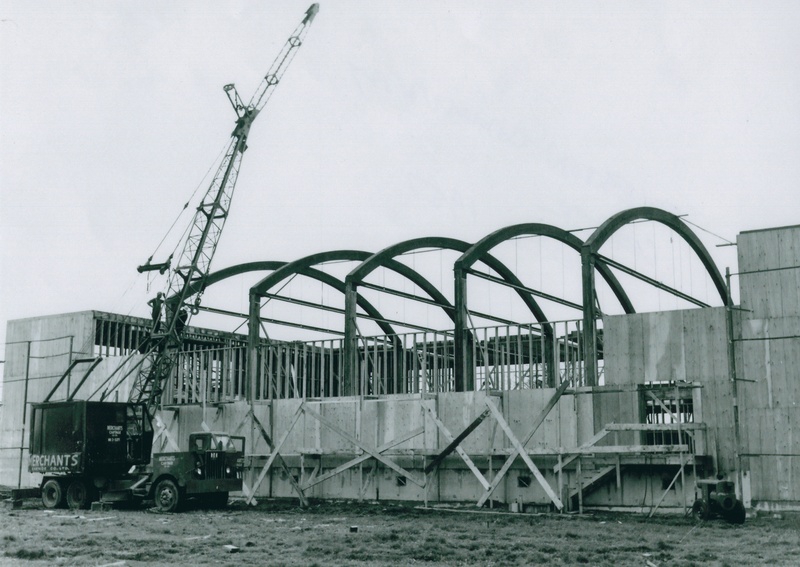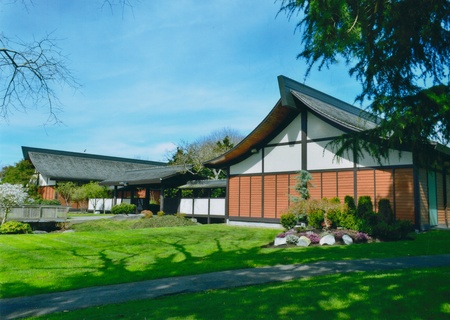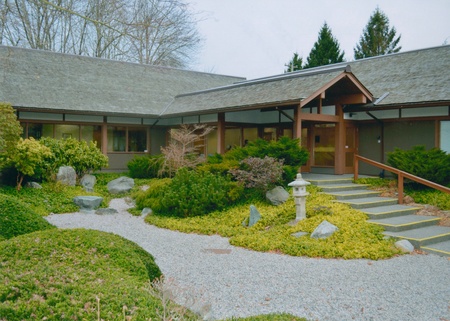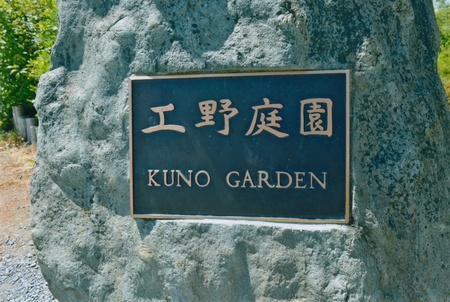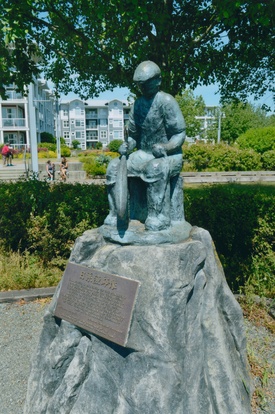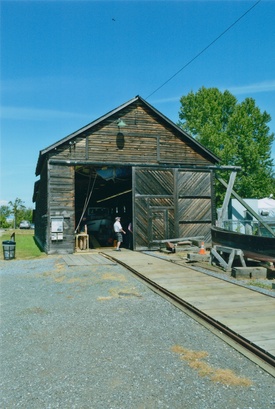Steveston, at the southern end of the city of Richmond, had long been home to a large and active Japanese community—until 1942, when all Japanese Canadians were removed from the west coast of Canada.
The Steveston Community Society (SCS) was incorporated on September 17, 1946, with the objective to promote the establishment of a community centre in Steveston.
Japanese Canadians were allowed to return to the B.C. coast beginning in 1949, and, upon their return to Steveston, they immediately re-engaged with the local community. In 1952, at the first meeting of the Japanese Canadian Citizens League (JCCL), the topic of building a community centre was raised. Rintaro Hayashi, acting chairman, assisted by Genji Otsu and D. Tamemoto, listened to a presentation made by B.C. Packer president Ken Fraser, who was also a member of the Steveston SCS. Mr. Fraser asked the JCCL to support the construction of the first community centre in Richmond, and this was unanimously supported.
Japanese Canadians soon joined the SCS, the most prominent community organization of its day. The minutes of the February 14, 1955, SCS meeting record that “Mr. Sid Teraguchi informed the meeting that the Japanese Canadian Community Association (JCCA) had approximately $15,000 and wished to build a hall.
But rather than build a small one of their own they were interested in joining with the Community Society in their endeavor toward a community centre.”
On April 11, 1955, Bob Kosaka was elected First Vice- President of the JCCA and reported that his organization had agreed to combine its trust account with that of the SCS for the purpose of building the Steveston Community Centre. This donation was contingent on two provisions: that one room be set aside for the judo club and that the gym could be used by the kendo club.
The Steveston Community Centre was officially opened on November 2, 1957. In his book titled Steveston: A Community History, author Bill McNulty stated that new program attractions relating to Japanese and First Nations culture were added to the community centre’s programming.
The community centre functioned under an operating agreement with the City of Richmond and required the SCS to pay for all maintenance and repair costs. Eventually this operating agreement was amended so that the SCS was tasked with hiring program staff and the City was responsible for building maintenance and other ancillary costs.
In 1960 the Steveston Japanese Language School relocated to the Steveston Community Centre from the Steveston Buddhist Temple. The major fundraiser for the Language School was an annual bazaar that was held every spring, beginning in 1961. This event took over the whole community centre with the upstairs banquet room used for the sale of udon and other Japanese foods. Downstairs, in the gym, a variety show featured singers, dancers, and musicians. Everyone in Steveston looked forward to the bazaar, as Japanese foods were not widely available back then. Unfortunately, in 2002, the bazaar was cancelled due to the lack of volunteers.
The judo and kendo clubs flourished in the new community centre, but it soon became apparent that the growth of both these clubs would soon outgrow the space. In 1972, Jim Murray, a city councilor and the first Caucasian to obtain his shodan (black belt) in kendo, suggested the idea of a building dedicated to the practice of martial arts as a Centennial project. Bob McMath, a fellow councillor, supported this, and even though there were competing Centennial projects, the martial arts centre was selected for funding.
The Nikkei community, spearheaded by the judo and kendo clubs, committed to raising $95,000 of the estimated $237,000 building costs. The support of the SCS was essential in completing the martial arts centre. However, at the end, not enough monies were raised.
Jack Gilmore, then-president of the SCS, and Ted Lorenz, a long-time supporter of the Nikkei community, as well as two other Board members felt strongly enough about the need for a martial arts centre that they signed a $15,000 mortgage so that construction could commence. The two martial arts clubs were able to raise the remaining funds and the mortgage was paid out. This was just another example of how the different ethnic groups in Steveston came together to work towards a common cause. The building officially opened on March 18, 1972, with S. Hori, Consul General of Japan, in attendance as well as many other dignitaries and guests. The martial arts centre was recognized as the first purpose-built dojo outside of Japan. A few years later, at the request of Mayor Uchiage of newly formed sister city Wakayama, a karate club was established and became the third club to utilize the martial arts centre. Uchiage made this request after discovering that the new martial arts centre did not have a karate program. His son, Takeshi Uchiage, was sent here to start the club. Jim Kojima was instrumental in having the karate club established as both the judo and kendo clubs would have to set aside time for the karate club to operate. Takeshi is still the head sensei, and his club members have won many national and international competitions.
The Steveston Nikkei community again asked for support from the general community in the early 1990s, when several members of the Nikkei community decided to make application for monies available through the Japanese Redress Committee. Surveys and public meetings were held, and Steveston citizens supported the construction of a Japanese Canadian Cultural Centre. The Redress Committee approved a grant of $500,000 towards its construction, and the provincial government provided $256,000 through the GO BC fund.
The Japanese Canadian Cultural Centre officially opened on September 12, 1992. It became the new home of the Steveston Japanese Language School and much other Japanese-related programming.
In addition to working and partnering with the SCS, the Nikkei community has, since the late 1950s, actively participated in the annual Steveston Salmon Festival, which celebrates Canada’s birthday on July 1. The first major participation was the Japanese Language School’s sponsorship of a chow mein booth as a thank-you to the SCS for its support. The booth was soon hosted by all of the Nikkei non-profit groups in Steveston, including the kendo, judo, and karate clubs, the Japanese Language School, and the Steveston Buddhist Temple fujin-kai ladies.
The chow mein booth takes a considerable amount of effort. A few days before the event, 50 to 60 volunteers gather in the upstairs banquet room of the community centre to chop vegetables and cook pork. The noise from chopping is so loud that you can’t even carry on a conversation! On July 1, members of the various Nikkei organizations cook, serve, and take cash. It takes close to 100 volunteers to staff the chow mein booth each year. All proceeds from the booth are donated to the SCS in recognition of its continued support for Nikkei programs.
In addition to the chow mein booth, an annual Japanese cultural show is held in the cultural centre and martial arts centre. Displays and demonstrations are held throughout the buildings, including bonsai, ikebana, martial arts, a tea ceremony, koto performances, odori, and so on. Between 80,000 and 100,000 guests visit Canada’s self-proclaimed “Biggest Little Birthday Party since 1945.” It takes approximately 150 volunteers to host this cultural show.
Though this article highlights the relationship between the Steveston Community Society and the Nikkei community, it should be recognized that there is also a long-established relationship between the City of Richmond and the Japanese Canadian community.
City Council has approved a myriad of projects and initiatives in support of the Japanese culture and history in Steveston and Richmond. In 1973, in recognition of its Japanese heritage, Richmond joined with the City of Wakayama as its sister city. This relationship remains strong to this day with visits and cultural exchanges made between the two cities every few years.
The City supported the establishment of Kuno Gardens at Garry Point Park in 1988, commemorating the 100th anniversary of the arrival of Gihei Kuno. Kuno was the first immigrant from Mio, a small village in Wakayama prefecture, and he encouraged an additional 250 villagers to come to B.C. Every year, the Wakayama kenjin-kai volunteer to prune the garden’s trees and vegetation. In 2000, the City supported the planting of 300 Japanese cherry trees in Garry Point Park by the Wakayama kenjin-kai, and, more recently, financially supported the first Cherry Blossom Festival in 2017.
As a requirement of the rezoning of the ANAF property, they had to set aside funds to create a plaza at the southwest corner of their property. This ANAF property was the previous site of the Fisherman’s Hospital. The plaza commemorates the site as the location of the Japanese Fisherman’s Hospital, the first permanent hospital in Richmond operated on the principle of socialized medicine.
In 1998, the City supported the restoration of Murakami House and Boatworks at the Britannia Historic Shipyards. This home was built in 1885 and is typical of the housing that the Japanese fisherman and cannery workers lived in. Also preserved on the Britannia site is the Kishi Boatworks building, which is currently used by the Britannia Shipyard Society.
More recently, City Council approved a grant for $100,000 in support of the creation of “Nikkei Stories of Steveston,” a series of 10 short videos depicting persons or events related to Nikkei history in Steveston. As well, City Council donated $330,000 towards the creation of an appropriate memorial commemorating the 75th anniversary of the removal of Richmond residents of Japanese descent, and, more importantly, their return and their contributions to the development of the community. This project is currently ongoing and it is hoped that an official unveiling can occur in 2018.
Steveston demonstrates a unique relationship between a visible ethnic group and the rest of the community and is a true example of Canadian multiculturalism at work.
*This article was originally published in Nikkei Images, Volume 22, No. 3.
© 2017 Kelvin Higo


